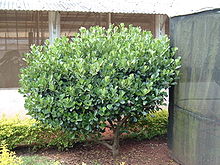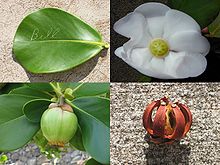- Clusia
-
Clusia 
Clusia fluminensis Scientific classification Kingdom: Plantae (unranked): Angiosperms (unranked): Eudicots (unranked): Rosids Order: Malpighiales Family: Clusiaceae Subfamily: Clusioideae Tribe: Clusieae Genus: Clusia
L.Species Around 145, see text
Synonyms Androstylium Miq.
Cochlanthera Choisy
Decaphalangium Melch.
Havetia Kunth
Havetiopsis Planch. & Triana
Oedematopus Planch. & Triana
Oxystemon Planch. & Triana
Pilosperma Planch. & Triana
Quapoya Aubl.
Renggeria Meisn.
Rengifa Poepp. & Endl. Autograph tree (C. major): leaf with autograph, flower, fresh fruit, and dried fruit
Autograph tree (C. major): leaf with autograph, flower, fresh fruit, and dried fruit
Clusia is the type genus of the family Clusiaceae. Comprising 140-150 species, it is native to tropical and subtropical America. Its species are shrubs, vines and small to medium-size trees up to 20 m tall, with evergreen foliage. Some species start life as epiphytes, then developing long roots that descend to the ground and eventually strangle and kill the host tree, in a manner similar to strangler figs.
The leaves are opposite, 5-20 cm long and 5-10 cm broad, with a leathery texture and an entire margin. The flowers are white to greenish-white, yellow or pink, with 4-9 petals. The fruit is a leathery greenish-brown valvate capsule which splits open to release several red, fleshy-coated seeds.
The genus Clusia was named in honor of botanist Carolus Clusius.
Selected species
- Clusia arborea
- Clusia carinata
- Clusia clarendonensis
- Clusia clusioides
- Clusia croatii
- Clusia cupulata
- Clusia fluminensis Planch. & Triana
- Clusia guttifera
- Clusia lanceolata
- Clusia longipetiolata
- Clusia major – Copey, Autograph Tree, Pitch-apple
- Clusia minutiflora
- Clusia osseocarpa
- Clusia palmicida
- Clusia plurivalvis
- Clusia polystigma
- Clusia portlandiana
- Clusia pseudomangle
- Clusia rosea – Scotch attorney, Autograph Tree, Pitch-apple
- Clusia skotaster
- Clusia tarmensis
- Clusia uvitana
- Clusia valerioi
External links
 Media related to Clusia at Wikimedia Commons
Media related to Clusia at Wikimedia Commons
This Clusiaceae article is a stub. You can help Wikipedia by expanding it.
